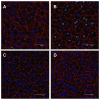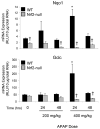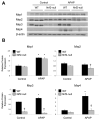Induction of Mrp3 and Mrp4 transporters during acetaminophen hepatotoxicity is dependent on Nrf2
- PMID: 17935745
- PMCID: PMC2214834
- DOI: 10.1016/j.taap.2007.08.022
Induction of Mrp3 and Mrp4 transporters during acetaminophen hepatotoxicity is dependent on Nrf2
Abstract
The transcription factor NFE2-related factor 2 (Nrf2) mediates detoxification and antioxidant gene transcription following electrophile exposure and oxidative stress. Mice deficient in Nrf2 (Nrf2-null) are highly susceptible to acetaminophen (APAP) hepatotoxicity and exhibit lower basal and inducible expression of cytoprotective genes, including NADPH quinone oxidoreductase 1 (Nqo1) and glutamate cysteine ligase (catalytic subunit, or Gclc). Administration of toxic APAP doses to C57BL/6J mice generates electrophilic stress and subsequently increases levels of hepatic Nqo1, Gclc and the efflux multidrug resistance-associated protein transporters 1-4 (Mrp1-4). It was hypothesized that induction of hepatic Mrp1-4 expression following APAP is Nrf2 dependent. Plasma and livers from wild-type (WT) and Nrf2-null mice were collected 4, 24 and 48 h after APAP. As expected, hepatotoxicity was greater in Nrf2-null compared to WT mice. Gene and protein expression of Mrp1-4 and the Nrf2 targets, Nqo1 and Gclc, was measured. Induction of Nqo1 and Gclc mRNA and protein after APAP was dependent on Nrf2 expression. Similarly, APAP treatment increased hepatic Mrp3 and Mrp4 mRNA and protein in WT, but not Nrf2-null mice. Mrp1 was induced in both genotypes after APAP, suggesting that elevated expression of this transporter was independent of Nrf2. Mrp2 was not induced in either genotype at the mRNA or protein levels. These results show that Nrf2 mediates induction of Mrp3 and Mrp4 after APAP but does not affect Mrp1 or Mrp2. Thus coordinated regulation of detoxification enzymes and transporters by Nrf2 during APAP hepatotoxicity is a mechanism by which hepatocytes may limit intracellular accumulation of potentially toxic chemicals.
Conflict of interest statement
CONFLICT OF INTEREST STATEMENT
The authors do not have interests which conflict with publication of the data in this manuscript.
Figures








References
-
- Aleksunes LM, Scheffer GL, Jakowski AB, Pruimboom-Brees IM, Manautou JE. Coordinated expression of multidrug resistance-associated proteins (Mrps) in mouse liver during toxicant-induced injury. Toxicol Sci. 2006b;89:370–379. - PubMed
-
- Aleksunes LM, Slitt AM, Cherrington NJ, Thibodeau MS, Klaassen CD, Manautou JE. Differential expression of mouse hepatic transporter genes in response to acetaminophen and carbon tetrachloride. Toxicol Sci. 2005;83:44–52. - PubMed
-
- Bai J, Lai L, Yeo HC, Goh BC, Tan TM. Multidrug resistance protein 4 (MRP4/ABCC4) mediates efflux of bimane-glutathione. Int J Biochem Cell Biol. 2004;36:247–257. - PubMed
-
- Barnes SN, Aleksunes LM, Augustine LM, Scheffer GL, Goedken M, Pruimboom-Brees I, Jakowski A, Cherrington NJ, Manautou JE. Induction of hepatobiliary efflux transporters in acetaminophen-induced acute liver failure cases. Accepted in Drug Metabolism and Disposition 2007 - PubMed
Publication types
MeSH terms
Substances
Grants and funding
LinkOut - more resources
Full Text Sources
Research Materials
Miscellaneous

